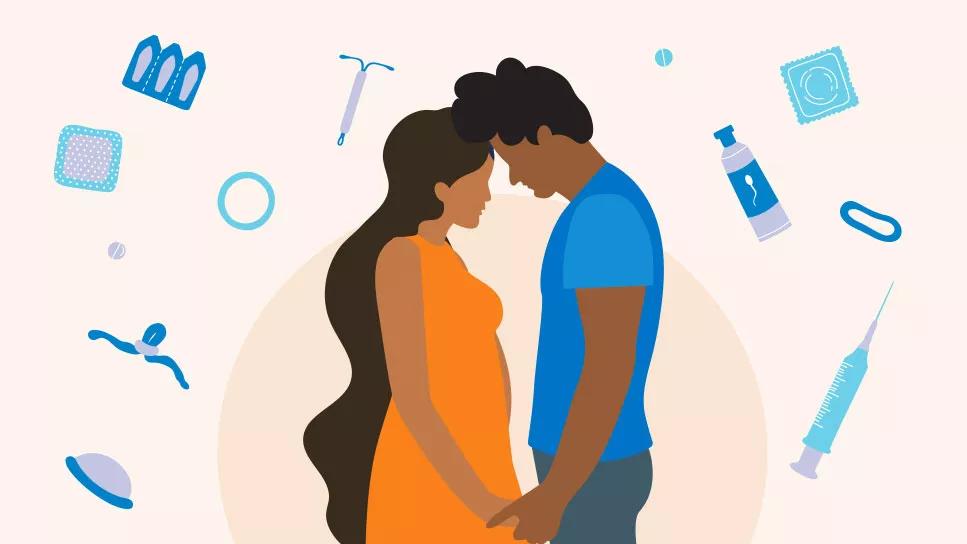‘Safer sex’ means STI prevention, avoiding unintended pregnancies and psychologically safe practices for everyone

Safe sex has carried various definitions over the years and it can mean different things to different people. But the overall point of safe sex (also known as safer sex) is to minimize your risk for harm, infection and unwanted experiences, including unintended pregnancies. Safe sex practices are also meant to provide the same protections to those you’re sexually active with.
Advertisement
Cleveland Clinic is a non-profit academic medical center. Advertising on our site helps support our mission. We do not endorse non-Cleveland Clinic products or services. Policy
Safe sex practices apply to everyone. No matter your sexual history or the type of relationship you’re in (or not in), you can benefit from understanding and practicing safe sex.
Primary care physician Antonia “Nia” Nwankwo, MD, shares what safe sex practices are, ways you can make your next sexual experience even safer and tips for disclosing any potential sexually transmitted infection (STI) status.
Safe sex refers to practices used during sexual activity to prevent the exchange of body fluids like semen, vaginal fluids or blood. It also includes practices that help you and your partner(s) feel safe psychologically.
For safe sex to be effective, you have to make an intentional effort to prevent unintended pregnancies and the spread of STIs and encourage feelings of safety during:
Advertisement
“Historically, people initially thought of safe sex as primarily pregnancy prevention,” notes Dr. Nwankwo.
And pregnancy prevention is still an important aspect of sexual health and safe sex. To help prevent unintended pregnancy, there are several birth control options to choose from, including:
Condoms, in particular, offer barrier protection that doubles as a way to prevent STIs as well as unintended pregnancies. The goal of barrier protection is to limit the transfer of body fluids from one person to another.
You can purchase condoms at pharmacies, grocery stores and other shops where over-the-counter medications are sold. Types of condoms to consider using include:
“Safe sex includes using condoms on things that are not just penises,” explains Dr. Nwankwo. “You should prepare to have protection for toys and other accessories you use on your own or with other people present to prevent the transmission of STIs or injury.”
The key to STI prevention is protecting yourself, your partners and other people from acquiring infections that can either be short-term and treatable or lifelong, but manageable, infections.
Some common STIs that condoms and barrier protection can prevent include:
And when it comes to HIV specifically, a daily antiviral medication called pre-exposure prophylaxis (PrEP) is 99% effective at preventing an HIV infection. That means anyone can take PrEP as an added preventive measure against infection the same way someone might take a daily contraceptive to ward off unwanted pregnancy.
“Anytime you have sex, there is a risk factor for getting an STI,” says Dr. Nwankwo. “In the setting of safe sex, technically no sex is safe. But there are safer sex practices.”
STIs are commonly transmitted through oral, vaginal and anal sex or from skin-to-skin contact when blood or other body fluids are present or exchanged. But some STIs can be transmitted even when you’re not having sex. That means you can get some STIs (like herpes or syphilis) from kissing.
“With kissing, if one person has herpes, the other person can get herpes. Just like if one person has a cold, the other person can get a cold,” explains Dr. Nwankwo. “This happens because we’re swapping fluids.”
Advertisement
Still, makeout sessions are considered lower-risk activities when compared to oral, anal or vaginal sex. And there are other safer sex practices, too, like mutual masturbation, cuddling or massages. All of these incorporate a higher level of intimacy with lower levels of risk for transmitting STIs.
The risk of infection, of course, is never zero, but there is always room to ensure the sexual practices you’re participating in are safer. And that idea has inspired many clinicians to start using the term “safer sex” instead of “safe sex” to communicate that there is always a risk.
“For instance, if you’re engaging in oral sex, you can make that practice safer by using barrier protection such as a condom,” further explains Dr. Nwankwo. “And two women may think there’s no need for a condom, but considering barrier protection like dental dams is another safer sex practice that can and should be discussed among partners.”
Of course, you can always abstain from sex, too.
“Abstinence is the only 100% way to protect yourself from STIs because a lot of stuff is user-dependent and nobody does everything right 100% of the time,” she adds.
But abstinence isn’t for everyone. And while having a partner that you trust and keeping the number of partners you have down to a minimum can ensure a safer sex experience, there are ways to have safer sex even when you have multiple partners.
Advertisement
“If you bring your own barrier protection to the table and you are aware, you can have safer sex,” says Dr. Nwankwo. “There is a higher risk factor for STIs when you have multiple partners because those people might have other partners. This means they are part of the equation for everyone’s safety. But a safer sex environment can exist if you have open lines of communication, you’re with people you trust and you consistently use protection.”
There are plenty of physical, emotional and psychological benefits of sex. But having safer sex brings important benefits that include:
Safer sex doesn’t just apply to your physical body — your mental and emotional health should also be protected when having sex, says Dr. Nwankwo. Safer sex should:
That means you should only participate in sex when you’re ready. You should communicate openly about your expectations and limitations. You should respect someone’s decision to say they’re not interested in a sexual activity. You should stop when you’re no longer feeling safe or comfortable. And you should be open to understanding your partner’s preferences while also honoring your own comfort and safety.
Advertisement
No matter what kind of relationship(s) you have or what sexual activities you engage in, Dr. Nwankwo emphasizes that using safer sex methods is an important part of making sure you and your partner have a mutually enjoyable experience that’s both safe and protective.
For example, people who have asexual relationships may not need to plan for barrier protection if they’re not participating in penetrative sex. But it’s still beneficial to have conversations about the kinds of intimacy you need and the kinds of activities you don’t want to participate in. Doing so ensures that whatever happens will meet your standard for psychological and physical safety — and that’s true, whether you’re having sex for the very first time or the 10th time.
Setting healthy boundaries and defining what you do and don’t like are all safe sex practices that reinforce and strengthen anyone’s relationship with themselves and their partner(s). And expressing your limitations holds you and others accountable when it comes to achieving a standard that’s right for you in terms of psychological and physical safety.
These methods of safer sex are important even in nonpenetrative practices like roleplaying or BDSM (a term that describes sexual activities that incorporate varying levels of dominance, submission, control and/or pain).
“Although folks who participate in BDSM may not always need to plan for barrier protection, they still need to consider safe practices like having safe words, talking about your limitations and making sure toys and other accessories are safe and safely used,” reinforces Dr. Nwankwo.
To embrace safe sex practices, you have to start having the conversation about what safe sex means to you. Over time, as you engage in sexual activities alone or with others, you want to be consistent and reinforce these practices as much as possible — and revisit them every now and again. Dr. Nwankwo provides several tips for making your next sexual experience safer.
One of the largest barriers to safe sex is the inability to get past the social stigmas associated with sex. Give yourself the space and grace to talk openly about your expectations, to explore what safe sex practices work for you and what your limitations might be.
If you’re not comfortable having those conversations with your partner(s), ask yourself why. Try to identify the barriers that make it difficult to have them, and then try and slowly chip away at those barriers.
For instance, if you’re uncomfortable even buying barrier protection from the store, know that you’re not alone in that. You can take a friend, partner or trusted loved one to purchase them with you when you’re ready. And the more you continue to be prepared for any and all situations, the easier these decisions will become.
“It’s kind of like menstrual pads or tampons: When you’re young and you have to buy them, sometimes, you feel like everyone’s looking at you but that’s not true,” says Dr. Nwankwo. “We have to get beyond that stigma that unfortunately still comes up. You have to get past your embarrassment to protect yourself, as it’s well worth it.”
“There shouldn’t be a reason to avoid barrier protection,” says Dr. Nwankwo. “Everybody’s body is different, which is why they make different types of condoms. We have ultrasensitive condoms, warming condoms, ridged condoms, condoms that have flavors, condoms that glow in the dark, lambskin condoms — there are all types of condoms you can choose to protect yourself and your partner, enhance your sensation and make the overall experience enjoyable for all parties.”
The point is that no matter who you are or your anatomy, knowing how to apply barrier protection is a key component to having safer sex. It’s also especially important to know what to do when a condom breaks.
Not sure where to start or have never used barrier protection before? Try incorporating the use of condoms during foreplay as a way to normalize the practice between you and your partner(s). And if you’re looking for more preparation before introducing it, you can always practice by yourself.
“Self-experimentation is always a good starting place because it’s better to get used to things when it’s just you,” says Dr. Nwankwo. “There’s no pressure. There’s no performance anxiety, You can safely figure things out on your terms and at your own pace.”
“This can feel tricky sometimes because there are so many layers to our relationships,” recognizes Dr. Nwankwo. “Folks who are in open relationships, people who are pansexual, people in monogamous relationships — and even people who are in perceived, closed relationships that are actually open without their knowledge — can all benefit from having consistent conversations with their partners about what safe sex looks like in their relationships.”
To avoid confusion or miscommunication, Dr. Nwankwo suggests setting up your expectations early and revisiting them often. That means you should clearly establish:
All of this can occur in the effort to ensure your emotional, physical and mental health and safety are all established, supported and respected whenever intimacy comes into play. This also reinforces a sex-positive attitude.
“Having the conversation and being open-minded to explore what you or your partner(s) are into can pave the way to safer sex practices and more frequent conversations around each other’s expectations,” says Dr. Nwankwo. “Doing things together to build emotional bonds between partners outside of just physical sex can also promote your sexual well-being.”
“Safe sex and conversations about safe sex practices are always needed and should always be discussed,” says Dr. Nwankwo. “Those who are in closed long-term monogamous relationships have less risk factors, but that shouldn’t negate the need for STI testing when you’re being seen by your healthcare provider.”
At minimum, she suggests getting tested for STIs once a year even if you’re in a monogamous relationship or you’ve been married to one partner for a long time.
“I think at least once a year, you should bring up the thought of STI testing,” she continues. “You might decide you don’t need it this year. But as long as you and your partner discuss it, that’s what makes it a safer sex practice.”
For people who are more sexually active or have more than one partner, Dr. Nwankwo suggests getting tested every three to six months — and that’s a recommendation she makes for anyone of any age or relationship status.
“I do a sexual history for everybody,” she says. “If you’re 80 years old, I’m still going to ask you about your sexual history because age does not determine whether or not you’re sexually active.”
It’s easier to have safer sex when you’re prepared for any situation.
“In the setting of one-night stands or unplanned sexual encounters, the only way to be safe is to make sure you’re meeting someone you trust, have time to discuss what will happen and to always carry your own protection,” says Dr. Nwankwo. “You never want to rely on another person to protect you.”
Emergency contraception options prevent ovulation so a pregnancy can be avoided. Some situations where Plan B One-Step® or other emergency contraceptive options might be used include:
For it to be most effective, emergency contraception should be used as soon as possible, typically within three days of having sex. Some options are available over the counter. But others, like a copper IUD and prescription medications, will require a trip to a healthcare provider.
By now, we’ve covered many practices that can prevent or reduce the risk of STIs. But what if you have an STI — how can you continue to have sex safely without transmitting the infection? And how do you share the intimate knowledge of your status with your partner or partners?
Don’t worry — you’re not alone in wondering how to manage this scenario.
“This strikes a lot of fear in people’s hearts. But by saying something or disclosing your status, you’re providing your partner with all the information they need,” encourages Dr. Nwankwo. “This way, they can make an informed decision about their sexual health and well-being and whether or not they would like to have sex with you knowing that you currently have some type of infection.
“Secondly, it allows your partner to take necessary precautions to prevent any further spread of infection, and it fosters trust and open communication.”
When preparing for the conversation, be reflective on when and how you want to have it and who you want to share these details with. Do you want to send it in a text message? Or would you rather sit down in a quiet setting and have a more formal conversation about STIs?
Regardless of what STI you have, educate yourself before talking to your partner. They may have questions about how your STI is transmitted or what potential symptoms might arise if an infection occurs.
You may also want to explore prevention strategies to work into the conversation. For example, if you’re living with HIV, your partner may want to know about PrEP as an extra measure of protection.
And when you’re navigating the conversation, it’s really important to have empathy and be very clear and direct about the information you’re providing.
“Use ‘I’ statements, like saying, ‘I have been diagnosed with an STI and I want to talk to you about it because I care about your health and well-being,’” advises Dr. Nwankwo. “A very straightforward statement still expresses to your partner that you need to tell them very vital information. And in many ways, being honest about your status can sometimes strengthen the bond between partners.”
If you think you’ve been exposed to an STI, you want to get tested with your primary care provider within 24 to 48 hours of knowing about your potential exposure. Getting tested as soon as possible is always the best choice.
But if you don’t have a primary care provider, you can always go to an urgent care, express care or emergency room to request STI testing.
“Sexual health is health,” emphasizes Dr. Nwankwo. “We’re all made up of mind, body and spirit, and in an effort to feed all of those parts, we often seek pleasure. In the setting of seeking pleasure, you want to make sure you’re honest with yourself about what you like, honest with yourself about what you want to do and what risks you might be willing to take, and you want to prepare yourself for all of it.
“All of these things can promote a safer environment so that you can actually enjoy yourself and keep yourself and others safe.”
Learn more about our editorial process.
Advertisement

Some foods are thought to rev up your sex drive, despite lack of scientific evidence

Your sexual history directly influences your physical, mental and emotional health in a multitude of ways

It’s perfectly normal for gas pockets to ‘evacuate’ during the motions of sex

Stay away from hand lotion and honey, but coconut oil can do the trick

Arousal without orgasm can be uncomfortable, but it’s no reason to pressure sexual interactions

Reap these physical, emotional and psychological advantages

Embrace the diversity of sexual expression

For starters, is sex really exercise?

If you’re feeling short of breath, sleep can be tough — propping yourself up or sleeping on your side may help

If you fear the unknown or find yourself needing reassurance often, you may identify with this attachment style

If you’re looking to boost your gut health, it’s better to get fiber from whole foods